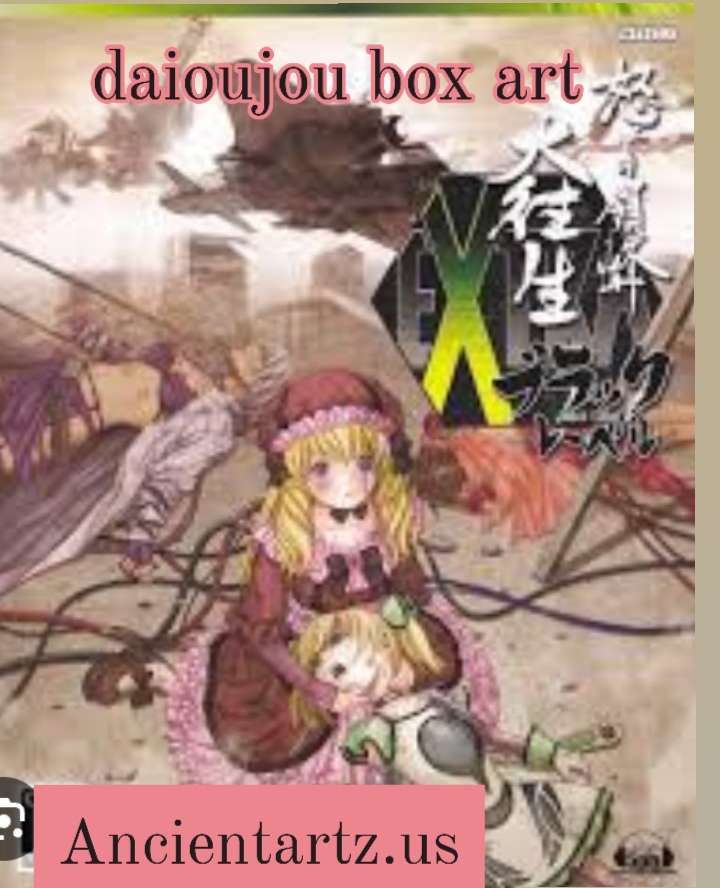Daioujou is a title that resonates with many gaming enthusiasts, especially those who are fond of the bullet hell genre. The game, developed by the Japanese studio Cave, first made waves in the early 2000s with its frantic pace, intricate mechanics, and hypnotic visuals. But as much as the gameplay itself, Daioujou is also celebrated for its striking and unique box art. The cover design for this game stands out as a testament to the creative vision of its artists, as well as the culture surrounding arcade gaming in Japan during its heyday.
In this article, we will explore the significance of the Daioujou box art, analyze its visual elements, and understand how it captures the essence of the game. Moreover, we will discuss how the box art aligns with the game’s genre, the story it tries to tell, and the cultural context in which it was released. From design intricacies to the impact of visual storytelling, we will dive into every element that makes the Daioujou box art a collector’s treasure.
A Glimpse Into the Bullet Hell Genre
Before delving into the specifics of the Daioujou box art, it’s important to first understand the bullet hell genre. This subgenre of shoot ’em up games is characterized by overwhelming patterns of bullets or projectiles that the player must navigate through while simultaneously shooting enemies. This kind of game demands precision, quick reflexes, and a deep understanding of enemy patterns and game mechanics.
Daioujou is part of the larger DonPachi series, known for its unforgiving difficulty and complex gameplay mechanics. As the third entry in the series, Daioujou takes everything that made its predecessors great and elevates the experience to a new level. But why is the box art so critical in this context?
Understanding the Role of Box Art in Gaming
The box art of any game serves as its first point of contact with potential players. It is the visual gateway that invites people to pick up the game, explore it, and eventually experience it. In the case of Daioujou, the box art does much more than just represent the game. It encapsulates the intensity, aesthetic, and atmosphere of the entire experience.
For fans of the bullet hell genre, the cover of Daioujou is a striking visual statement. It sets the tone for the frenetic gameplay that lies within, allowing players to anticipate the chaos that the game promises.
The Symbolism Behind the Design
The cover art of Daioujou is a masterful blend of symbolism and style. The design often features sharp, geometric shapes, glowing colors, and intricate patterns. These visual elements mirror the gameplay itself, which is filled with complex patterns of bullets and enemies.
The inclusion of key characters or enemies on the cover art also serves to foreshadow the challenges players will face. Daioujou is not just about mindless shooting; it’s about recognizing patterns and understanding the environment. The cover hints at this strategic element through its visual design.
Breaking Down the Visual Elements of the Box Art
Color Palette and Contrast
One of the most striking features of the Daioujou box art is its use of bold, contrasting colors. Often dominated by fiery oranges, reds, and cool blues, these colors are not merely aesthetic choices. They evoke emotions tied to the gameplay itself. The red and orange hues might suggest the intense, high-pressure nature of the game, while the blues create a sense of coldness and danger, highlighting the harsh environments players must navigate through.
The Dynamic Composition
The composition of the box art reflects the fast-paced, ever-shifting nature of Daioujou’s gameplay. The enemies and bullets are often arranged in sweeping, curved lines that lead the eye across the cover, mimicking the trajectory of projectiles in the game. The central figures or characters are usually placed in powerful stances, evoking a sense of action and readiness.
Character Design and Action Poses
The characters on the box art are often depicted in dramatic action poses, with intense expressions. These designs speak to the game’s focus on agility and quick reflexes. They symbolize the player’s role in navigating through a world full of bullets while shooting enemies. This visual representation directly connects with the core mechanic of Daioujou—the player’s ability to avoid destruction while aggressively advancing through the game.
Attention to Detail and Motion
The box art for Daioujou often incorporates dynamic elements that convey a sense of motion. Blurred lines or swirling effects can give the illusion of speed, reinforcing the idea that the player must constantly be on the move. This attention to detail not only enhances the visual appeal but also provides an insight into the intensity of the gameplay experience.
The Cultural Context: Japanese Influence on Game Art
The Daioujou box art is heavily influenced by the distinct aesthetic trends prevalent in Japan during the early 2000s. The graphic design style, with its use of neon colors, futuristic imagery, and abstract forms, is reminiscent of the vibrant art found in Japan’s arcade culture during that time.
Arcades as Cultural Hubs
Arcades were more than just places to play video games—they were social hubs where people came together to engage with new technology and immerse themselves in digital worlds. The design of Daioujou’s box art, with its bold colors and striking visuals, mirrors the high-energy environment of the arcades.
A Tribute to Japanese Animation
Incorporating aspects of anime-style character design is another key feature of the game’s cover art. The exaggerated expressions, highly detailed clothing, and stylized action poses recall the aesthetics of Japanese animation, which has a long history of influencing video game design.
The Impact on the Gaming Community
The Daioujou box art had a significant impact on both fans of the series and the larger gaming community. The combination of its visual complexity and the thematic undertones of chaos and control left a lasting impression. For many collectors and enthusiasts, owning the original box art was as important as mastering the game itself.
Collector’s Appeal
As with many vintage games, the original box art of Daioujou has become a sought-after piece for collectors. The vibrant and visually striking nature of the design makes it not just a game cover but an artifact of the gaming culture of the 2000s. For some, owning a copy of the game with its original box art is a way of preserving a piece of gaming history.
Inspiring Future Artists and Designers
The lasting influence of Daioujou’s box art extends beyond just the game’s players. Many artists and graphic designers have cited it as an inspiration for their own work. The bold design choices and dynamic action sequences in the art have influenced a new generation of artists in the gaming industry.
Conclusion: The Lasting Legacy of Daioujou’s Box Art
In conclusion, the box art for Daioujou is more than just a piece of promotional material—it is an artistic expression of the game’s core themes, its dynamic gameplay, and its cultural context. The vivid colors, intricate details, and action-packed composition serve as a perfect visual introduction to the game’s intensity. As an important piece of gaming history, the Daioujou box art continues to influence both game design and visual culture within the gaming community.
For fans of bullet hell games and lovers of game art, the box art for Daioujou stands as a symbol of the rich, intricate relationship between gameplay and visual storytelling. As long as there are collectors and fans who cherish the game’s heritage, the legacy of its box art will continue to endure.
FAQs
1. Why is the Daioujou box art so important?
The box art of Daioujou is an integral part of the game’s identity. It captures the essence of the game’s chaotic, high-intensity gameplay and sets the tone for what players can expect. The design elements reflect the challenges players will face and contribute to the game’s visual storytelling.
2. What makes the Daioujou box art unique?
The Daioujou box art stands out for its dynamic use of color, motion, and composition. The action-packed poses of characters, combined with bold, contrasting colors, make it a striking visual experience that mirrors the fast-paced gameplay of the title.
3. How has Japanese culture influenced the Daioujou box art?
Japanese culture, particularly anime and arcade gaming, has had a significant influence on the design of the Daioujou box art. The vivid colors, stylized characters, and emphasis on action are all elements drawn from Japanese visual trends of the time.
4. Is the Daioujou box art collectible?
Yes, the original box art of Daioujou has become highly collectible, especially for fans of retro gaming. Its vibrant design and association with a significant piece of gaming history make it a valuable item for collectors.
5. Can the box art be found on other merchandise?
While Daioujou‘s iconic box art is most closely associated with the game itself, its influence can be seen in various pieces of bullet hell merchandise and fan art, where the bold colors and dynamic compositions are often reinterpreted.


